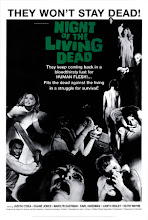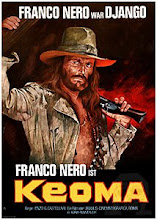
Italy/Spain 1966 colour
aka Texas Addio, Goodbye
Director Ferdinando Baldi Writers Ferdinando Baldi, Franco Rossetti
Cast Franco Nero (Burt Sullivan), “Cole Kitosch”/Alberto Dell'Acqua (Jim Sullivan), Elisa Montés (Mulatta Girl), José Guardiola (McLeod), José Suárez (Cisco Delgado)
Of course you’ve all heard the one about the dog that limps into town looking for the man who shot his paw. With that, welcome to a blood-soaked pair of spaghetti revenge operas starring Franco Nero.
 These days you forget what a name Nero was in the Sixties and Seventies. In 1966, the former army grunt turned physical actor starred in three westerns within six months - Django, Massacre Time and Texas Adios - before heading to
These days you forget what a name Nero was in the Sixties and Seventies. In 1966, the former army grunt turned physical actor starred in three westerns within six months - Django, Massacre Time and Texas Adios - before heading to
 Texas Adios, released in 1966, was a much more deliberately American western. Franco Nero is a clear-cut moral figure as Burt Sullivan, sheriff in a
Texas Adios, released in 1966, was a much more deliberately American western. Franco Nero is a clear-cut moral figure as Burt Sullivan, sheriff in a
 Like all great Italian westerns, Texas Adios is beautifully shot by Enzo Barboni, who as “EB Clutcher” would later create his own sub-genre of Trinity movies with Terence Hill and Bud Spencer. And, despite its allusions to the classic models of Gary Cooper and Jimmy Stewart, it’s a spaghetti western at heart, and its heart is cold and cruel. “Are you tired of leeeeving?” asks Delgado’s greasy right hand man, and the answer seems to be a resounding yes: sympathetic characters are disposed of with little fanfare, and Nero’s idealistic younger brother Jim played by Alberto Dell’Acqua is taught that becoming a man means becoming immune to killing.
Like all great Italian westerns, Texas Adios is beautifully shot by Enzo Barboni, who as “EB Clutcher” would later create his own sub-genre of Trinity movies with Terence Hill and Bud Spencer. And, despite its allusions to the classic models of Gary Cooper and Jimmy Stewart, it’s a spaghetti western at heart, and its heart is cold and cruel. “Are you tired of leeeeving?” asks Delgado’s greasy right hand man, and the answer seems to be a resounding yes: sympathetic characters are disposed of with little fanfare, and Nero’s idealistic younger brother Jim played by Alberto Dell’Acqua is taught that becoming a man means becoming immune to killing.
Me, I’m already numb to the wholesale slaughter, and you will be too, as we ride the blood-soaked plains in Texas Adios.
aka Desperado, Django Rides Again, Django's Great Return, The Violent Breed
Director Enzo G. Castellari Writers Enzo G. Castellari, Nico Ducci, Luigi Montefiori,
Cast Franco Nero (Keoma), Woody Strode (George), William Berger (William Shannon), Donald O'Brien (


 Cut to ten years later, and Franco Nero is an intentional superstar who returns for the first time in years to the dying artform that made him who he is, the spaghetti western. Director Enzo G. Castellari, a filmmaker for whom the word “subtlety” dropped off the end of his business card, obviously sees parallels in Franco’s story with that of his character Keoma. He’s a half-breed marksman who returns home after the Civil War to find a plague-ravaged landscape and his town run by corrupt landowner Caldwell, who won’t let medicine in and won’t let the plague victims out. It’s a dying town that resembles more of a medieval hamlet than the Wild West, and its apocalyptic feel is augmented with the mud and dust and constant sense of despair, with Nero perfectly cast as a Pale Rider delivering death from the end of his gun.
Cut to ten years later, and Franco Nero is an intentional superstar who returns for the first time in years to the dying artform that made him who he is, the spaghetti western. Director Enzo G. Castellari, a filmmaker for whom the word “subtlety” dropped off the end of his business card, obviously sees parallels in Franco’s story with that of his character Keoma. He’s a half-breed marksman who returns home after the Civil War to find a plague-ravaged landscape and his town run by corrupt landowner Caldwell, who won’t let medicine in and won’t let the plague victims out. It’s a dying town that resembles more of a medieval hamlet than the Wild West, and its apocalyptic feel is augmented with the mud and dust and constant sense of despair, with Nero perfectly cast as a Pale Rider delivering death from the end of his gun.
 Keoma finds his father almost at the end of his rope, and his three half-brothers on
Keoma finds his father almost at the end of his rope, and his three half-brothers on
 From the last dying gasps of the spaghetti western cycle, Keoma means to be the final word, a coda to the apocalyptic tradition begun by Franco Nero’s Django in 1966. Castellari’s characters all burst blood vessels making every line profound, and you can tell the film itself is haunted by three ghosts. Sergio Leone is there in Keoma’s epic sweep and impressive camera theatrics, the ghost of Sam Peckinpah every time the bloodshed slows to a crawl, and the ghost of Pasolini in its overt religious symbolism - and by the end of the movie, the Jesus and Mary references are out of control.
From the last dying gasps of the spaghetti western cycle, Keoma means to be the final word, a coda to the apocalyptic tradition begun by Franco Nero’s Django in 1966. Castellari’s characters all burst blood vessels making every line profound, and you can tell the film itself is haunted by three ghosts. Sergio Leone is there in Keoma’s epic sweep and impressive camera theatrics, the ghost of Sam Peckinpah every time the bloodshed slows to a crawl, and the ghost of Pasolini in its overt religious symbolism - and by the end of the movie, the Jesus and Mary references are out of control.
 You, the audience, will be haunted by the theme song, a turgid folk-country nightmare sung by a would-be Joan Baez that pops its ugly head up in every scene. “Oooooooh, Keoma....” At the film’s mid point she’s joined by a guttural, atonal crooner, presumably Nero or an accomplice, who functions as a one-man Greek chorus: “Why do these men haaaaate me sooooooo...”
You, the audience, will be haunted by the theme song, a turgid folk-country nightmare sung by a would-be Joan Baez that pops its ugly head up in every scene. “Oooooooh, Keoma....” At the film’s mid point she’s joined by a guttural, atonal crooner, presumably Nero or an accomplice, who functions as a one-man Greek chorus: “Why do these men haaaaate me sooooooo...”
 A friend of mine describes this film as a lasagna western - one with many layers. Of cheese. Ladies and gentlemen, from the director of 1990 The Bronx Warriors, we present the final word - or is it? - in Italian westerns, the enjoyably pretentious 1976 Keoma.
A friend of mine describes this film as a lasagna western - one with many layers. Of cheese. Ladies and gentlemen, from the director of 1990 The Bronx Warriors, we present the final word - or is it? - in Italian westerns, the enjoyably pretentious 1976 Keoma.

























































































No comments:
Post a Comment